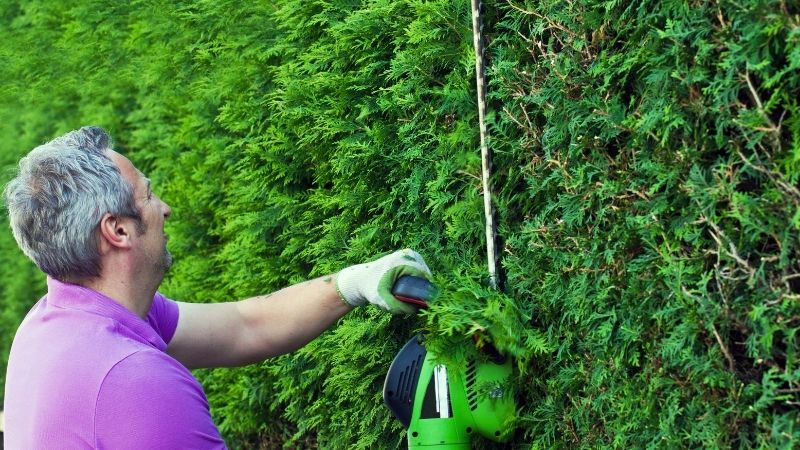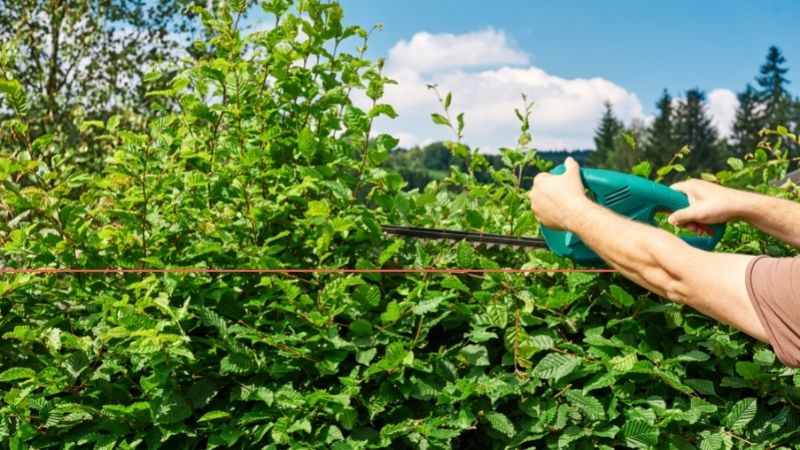Have you ever looked at your neighbor’s tall, neatly trimmed hedge and wondered how he manages to keep it looking so perfect? Maybe you also have a hedge on your property that desperately needs some maintenance. If you’re thinking about trimming tall hedges, there are a few things you should know before you start. In this blog post, we’ll give you some expert tips on how to trim tall hedges safely and effectively. Whether you’re a gardening newbie or a seasoned pro, read on to learn everything you need to know about trimming tall hedges!
Contents
- 1 Why should you trim tall hedges?
- 2 When is the right time to cut a high hedge?
- 3 Pruning high hedges
- 4 The height cut
- 5 The outer cut
- 6 The inner cut
- 7 Frequently asked questions about trimming high hedges
- 8 When is it allowed to cut the hedge?
- 9 How often should the pruning be done?
- 10 Is it possible to rejuvenate an old hedge?
- 11 Author
Why should you trim tall hedges?
When a hedge is planted, it starts out small. Once the young shoots take root, the small, flat hedge quickly becomes a tall hedge.
Under favorable conditions, such a high hedge can reach a height of 4 meters. This would bring serious problems, because the hedge grows not only in height, but also in width.
It would take up more and more space in the garden, until only time-consuming and energy-consuming radical pruning would help. A light topiary would no longer do the trick.
Often hedge plantings serve as living fences. However, there are different regulations for their height and distance from the neighboring property in different states. In most cases, hedge plants may not exceed 2 meters in height and must maintain a distance of at least 50 centimeters from the neighboring property.
When is the right time to cut a high hedge?
The ideal time to trim a tall hedge to the desired shape is late winter or early spring, the months of February or March. Radical pruning should be done before the bird breeding season begins.
The weather also plays a role in determining the right time. It should be frost-free, but not sunny.
Pruning high hedge – explained step by step
- The right tools
- Ladder
- Hedge trimmer
- Branch shears
- Rose shears
- String and stakes
- Protective clothing
Instead of a ladder, you can also use a telescopic hedge trimmer. It is safer and more comfortable to work from the ground.
If severe pruning is necessary or the hedge planting has already grown very vigorously, reach for an electric hedge trimmer or use a motorized hedge trimmer.
When pruning, a second person should always be present. He or she will hold the ladder and make sure that the pruning is done in the desired shape.
Pruning high hedges
When pruning a tall hedge, there are 3 types of cuts:
- Height pruning
- Outside pruning
- Interior pruning
Ideally, you should cut the hedge in a trapezoidal shape.
The height cut
This cut you should do first. To do this, drive the stakes into the ground and stretch a mason’s twine to create a reference line for the desired height.
Shorten the plants step by step in several stages, so that the hedge gets a nice shape. The second person makes sure that the cut is straight and even.
Shorten the upper branches so that the cut ends are covered by the foliage, so they are not so noticeable.
The outer cut

This form of pruning should always be done after the height pruning. If there is no reference line such as a fence or wall, use a taut string.
Work slowly and carefully to avoid large gaps or crooked areas. The second person should watch the work from a distance and correct you in time to achieve a nice cut shape.
Cut from the outside to the inside. The young shoots of the previous year can be completely removed. Also shorten overhanging branches, especially if they protrude onto the neighbor’s property.
For outside pruning, proceed similarly to height pruning, shortening thick branches or stems first. The foliage of the thin branches should cover the cut edges.
Give the hedge planting the desired geometric shape. Most gardeners prefer a trapezoidal cut. Be careful not to trim the hedge planting too much at the bottom.
The inner cut
To achieve a beautiful and uniform geometric shape, it is necessary to perform pruning from the inside as well. This maintenance measure ensures an even, dense growth.
During internal pruning, you remove diseased and dead branches that no longer bear branches and leaves. There is little light inside dense hedge systems, which can cause branches and leaves to die.
Gain access to the interior at a convenient location. You can use the existing thick branches as a ladder.
Use a saw or loppers with sharp blades. An electric hedge trimmer is unsuitable for interior pruning because it takes up too much space.
Interior pruning requires experience and dexterity. You must work carefully so that there is no open space where you remove a branch.
Before cutting, bend the branch up or down and ask the helper to observe whether an open spot forms. If in doubt, it is better to leave the branch in place.
Frequently asked questions about trimming high hedges
When is it allowed to cut the hedge?
Legislation prohibits removal or radical pruning between March 1 and September 30 because that is the bird breeding season. The only exception is the removal of a hedge plantation in the course of a construction project. This requires a special permit. However, fine topiary and light maintenance pruning is permitted during the aforementioned period.
How often should the pruning be done?
It depends on what woods were planted. Cherry laurel, barberry, yew, thuja and false cypress only need to be pruned once a year. Other woods such as field maple, copper beech, privet and hornbeam need pruning twice a year. Pruning causes the hedge to become denser.
Is it possible to rejuvenate an old hedge?
This is possible with plantings of deciduous shrubs such as privet or copper beech. You will need to do a radical pruning, shortening the stems well into the old wood. The main branches can be sawed off to about 30 cm above the ground. The new shoots next spring must be shortened again by at least a third. For deciduous woody plants, early spring is the best time, for evergreen woody plants, early summer.


